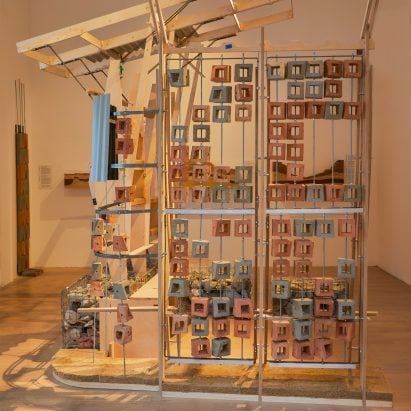Palestine Regeneration Team’s contribution to the British Pavilion is one of the few projects at this year’s Venice Architecture Biennale to address the ongoing war in Gaza. Here, the architecture group tells Dezeen that more architects need to speak out against injustice.
As part of the British Pavilion’s exhibition, the Palestine Regeneration Team presented an installation titled Objects of Repair, which explores the potential of using salvaged materials to rebuild war-torn Gaza.
The group said that, aside from its own, there is a notable absence of projects referencing Gaza and Palestine at the biennale.
British Pavilion “the only one to address the most serious current humanitarian disaster”
“The inclusion of Palestine Regeneration Team’s work in the British Pavilion’s exploration of colonial histories exemplifies the Venice Architecture Biennale’s capacity and responsibility to engage with urgent global issues,” group member Nasser Golzari told Dezeen.
“The British Pavilion’s strength is that it does examine these kinds of problems full on, and it is to their credit that the curators were prepared to include Palestine in the discussion,” added group member Murray Fraser.
“As far as I could see, it is the only pavilion to address directly what is the most serious current humanitarian disaster.”
Objects of Repair explores using salvage materials to rebuild Gaza. Photo by Chris Lane
This year’s Carlo Ratti-curated biennale stands in comparison to last year’s Venice Art Biennale, which featured numerous works related to Palestine in national pavilions and the central Arsenale exhibition, as well as pro-Palestine protests interrupting the event’s preview days.
Fraser drew comparisons between this year’s event and Lesley Lokko’s 2023 architecture biennale, which had a theme centred on decolonisation and decarbonisation.
“If the 2023 biennale was intended to celebrate geopolitical change, this year it seems to be about denying it,” he said. “Sadly, the architectural profession is letting Gaza down with its ongoing silence.”
“We all should be speaking out as our voice matters and challenge the normalisation of spacio-cide in any part of the world,” Fraser added.
Israel’s military campaign in Gaza has escalated since it broke the ceasefire on 18 March, in what was reportedly Gaza’s deadliest 24 hours since the war’s first months in 2023.
The BBC reported that Gaza’s health ministry puts the total death toll from Israel’s war on Gaza at 54,470 since 7 October 2023, including 4,201 since 18 March. Israel launched its military campaign in response to Hamas’ deadly attacks on 7 October 2023, in which around 1,200 people were killed and 251 taken hostage.
“If the biennale is not the place to confront these issues, then when?”
The Palestine Regeneration Team argued that the architecture profession needs to do more to speak out against Israel’s war on Gaza, which has seen at least 92 per cent of housing in the region destroyed or damaged, according to the United Nations.
“The architectural profession needs to engage with the subject of Palestine and what is happening now in Gaza under occupation,” said group member Yara Sharif. “This discourse is urgently needed.”
“As architects, we believe it is our professional ethical responsibility to speak out against all forms of injustice – political, environmental, and spatial – whether in Palestine, Sudan, Lebanon or Kenya.”
“After all, the exploitation and use of land is deeply rooted in colonial agendas,” she continued. “If the biennale is not the place to confront these issues, then when?”
Although Objects of Repair is one of the only installations to reference Gaza at the biennale, the Palestine Regeneration Team highlighted that there are some projects that address conflict and political issues in different ways.
The Lebanese pavilion tackles the theme of ecocide as a weapon of war, which Golzari and Sharif said, “resonates deeply with the themes we are exploring in Objects of Repair, imagining pathways for hope and restoration amidst crisis”.
Elsewhere at the biennale, Latvia’s pavilion explores the impact of defensive structures built on NATO’s borders, and Ukraine’s pavilion features a roof structure designed to symbolise rebuilding and protection amid the country’s current war.
“There is a general avoidance of the pressing issues of our times” at the biennale
When announcing the theme of this year’s biennale, Intelligens Natural Artificial Collective, Ratti told the audience that “there’s going to be a lot of science”. He later told Dezeen that the core focus is the climate crisis and people.
Fraser argued that many responses to the theme were projects that focused on technology at the expense of addressing global issues.
“The problem with the theme for this Venice biennale is that it heightens a tendency to propose individual or small team responses involving a mostly spurious use of new technology,” he said. “There is something deeply technocratic within architecture that surfaces at moments like these, erasing social and cultural context.”
“As well as ignoring wider context, except in exceptions like the Lebanese exhibition, there is also a general avoidance of the pressing issues of our times, such as what is happening every day in Gaza,” Fraser added.
The top photo is by Eva Branscome.
Comments have been turned off on this story due to the sensitive nature of the subject matter.
The Venice Architecture Biennale takes place from 10 May to 23 November 2025. See Dezeen Events Guide for all the latest information you need to know to attend the event, as well as a list of other architecture and design events taking place around the world.
The post “Architectural profession letting Gaza down with its ongoing silence” says Palestine Regeneration Team appeared first on Dezeen.
